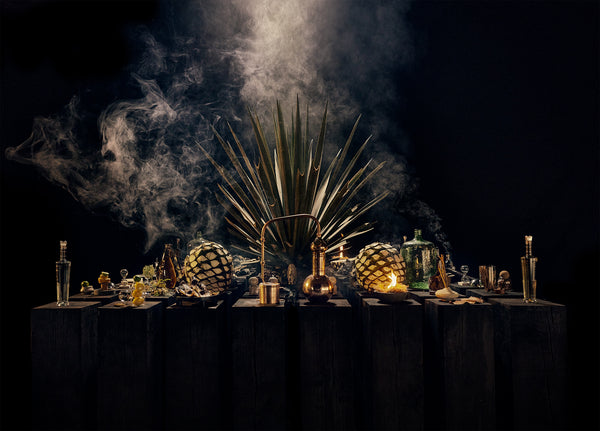The History of Tequila: Over 500 Years of Agave Distillation

Tequila is one of the most popular alcoholic beverages in the world. But whether you prefer to enjoy your tequila neat or in a margarita, you may not know about the spirit’s rich and storied history.
Ancient civilizations became the first to ferment the agave plant — a key ingredient of tequila — thousands of years ago. In the mid-16th century, European colonists began distilling the fermented agave to create a concentrated form of alcohol.
Today, modern-day master distillers and tequileros, like Enrique Fonseca and Sergio Mendoza of the famed La Tequileña Distillery (NOM 1146), draw upon ancestral knowledge in their pursuit of the perfect tequila.
Here’s a look at the history of tequila and how the cherished agave spirit has evolved over time.
The History of Agave: Before and After the Spanish Conquered the Aztec Empire
The history of tequila dates back to 1000 B.C.E., when the Olmec became the first civilization to ferment the agave plant.
When the Aztecs came to power in the 13th century, they continued the Olmec’s tradition and called the fermented beverage “pulque.” The Aztecs used pulque in their worship of ancient gods during religious ceremonies.
In 1519, at the peak of the Aztec Empire, the Spanish conquistador Hernándo Cortés landed in Mexico and the Spanish Aztec war was on. The war ended in August of 1521 when the Spanish officially conquered the Aztec empire.
The Spanish brought with them all sorts of knowledge from Europe, including knowledge of the process of distillation. Western European countries had been distilling various spirits since the eighth century and, by the year 1400, had perfected the process.
Although the fermentation of agave has existed for some 2,500 years, historians believe that the practice of distilling fermented agave did not begin until the 16th century. The first agave distillation occurred circa 1519-1521 after the Spanish had arrived and taken control of the land that is now Mexico. The Spaniards liked their brandy, and when supplies ran low they started using mud and agave to make a crude form of mezcal — an agave-based spirit that is distinct from tequila.
By the mid-16th century, the Spanish government had opened a trade route between Mexico and Manila. Sailors from the Philippines brought a variety of goods, including coconuts and portable stills, which they used to make coconut brandy. People in Mexico used those stills to begin distilling agave.
Around 1600, the Marquis of Altamira opened the first large-scale distillery in the town of Tequila in the Mexican state of Jalisco where, to this day, 95% of all tequila is made.
Tequila Production: What, Exactly, is Distillation?
Distillation is the process of separating alcohol from water. It’s one of the most important steps in the tequila production process. From crystal-clear blanco tequilas to bronze-hued extra añejo tequilas, every classification or “expression” of tequila undergoes the distillation process at least twice.
Distillation is the fifth and sometimes final step in the tequila-making process.
- Step 1: Harvest the agave. It takes a minimum of five years, sometimes longer, for the blue agave plant to mature and become ready to harvest.
- Step 2: Bake the piña, also known as the fruit or “heart” of the agave plant, in special ovens called hornos.
- Step 3: Shred the piña and extract the juice.
- Step 4: Ferment the juice. After fermentation, the juice becomes what’s commonly referred to as mosto.
- Step 5: Distill the mosto.
- Step 6: Distill it again.
- Step 7: Bottle or age the distilled spirit.
The distillation process is a key step because it purifies the mosto and concentrates the alcohol. After one distillation, the mosto is still cloudy. The second distillation makes it clear. It’s also now considered a blanco (aka silver tequila) and can be bottled immediately.
Reposado tequila, añejo tequila, and extra añejo tequila require aging before they can be bottled. After the last distillation, these expressions are placed in oak barrels to age for a minimum of two months up to three years or longer, depending on the expression. Longer aging times result in deeper colors and more complex flavors.
However, many distilleries in Mexico attempt to bypass the aging process by adding an eighth step to production: the use of additives.
Most tequila brands use additives like glycerin, oak extract, caramel coloring, and/or sugar-based syrups to their distilled spirits. Additives change the tequila’s flavors and make it appear as though it has been aged for a longer period of time.
Authentic tequila brands, like Cierto, do not use additives. At Cierto, master distillers Enrique Fonseca and Sergio Mendoza are committed to making the best additive-free tequila on earth. Cierto’s additive-free tequila expressions are not only higher quality, but also healthier and more authentic than those produced in distilleries that use additives to shortcut production times.
Learn More: Cierto Tequila Named Best Tequila at the 2024 Los Angeles Invitational Wine & Spirits Challenge

The Birth of Modern-Day Tequila
The tequila that we drink today has come a long way from the early versions enjoyed in the 16th and 17th centuries.
The Cuervo family began distilling agave in 1758, but it was in 1873 when the tequila-making process changed forever.
That year, the Sauza family began distilling tequila, but they didn’t use just any species of agave plant. They determined that the blue Weber agave species was best agave to use because it produced spirits with the highest alcohol content. Around this same time in the late 1800s, the Fonseca family started planting agave and supplying it to tequila distillers.
The identification of blue Weber agave as the best agave for tequila set a new standard. Since 1977, Mexican law states that for tequila to be classified as tequila, it must be made from blue Weber agave.
Any spirit that is made from an agave plant other than blue Weber agave is mezcal, which is different from tequila.
1949: Government Regulation of Tequila
In 1949, the Mexican government established the Norma de Calidad de Tequila (Tequila Quality Standard) to ensure that all tequila maintains a consistent quality. At the time, it could only be made from blue Weber agave in the state of Jalisco. Today, tequila can be made with blue Weber agave in Jalisco as well as four other Mexican states:
- Guanajuato
- Michoacan
- Nayarit
- Tamaulipas
1974: Tequila Becomes Intellectual Property
In 1974, the Mexican government declared “tequila” as intellectual property. It received a Denomination of Origin (DO), making Mexico the official home of all tequila.
While there exist many agave spirits that are distilled and bottled around the world, if they’re not made in Mexico using blue Weber agave, they are classified as mezcal.
In the mid-1980s, the Fonseca family expanded their agave cultivation business to open a distillery of their own. They purchased the more than century-old La Tequileña Distillery in Jalisco and turned it into one of the most respected tequila distilleries in the world.
1994: The Formation of the CRT
In 1994, the Mexican government formed El Consejo Regulador del Tequila, also known as the Tequila Regulatory Council or CRT, to certify and verify that all distilleries and all types of tequila met specific requirements.
Designed to guarantee the authenticity of all tequila, the CRT is still in place today.
Read About: Robb Report: Cierto is the “Best Overall Blanco”

Tequila in the 2000s
It wasn’t until the 2000s that 100% agave tequila became the norm. Legally, distilleries must only include a minimum of 51% blue Weber agave in their tequila, while the other 49% can consist of cane sugars. These are called mixtos, and although they still exist today, 100% blue agave tequila is the new standard.The Tequila Industry is Growing
Tequila has risen in popularity and the industry has seen rapid growth in recent years. It is now on track to become the best-selling alcohol in the United States.
Globally, tequila was a $14.7 billion industry in 2022. In the U.S., it’s outpacing all other spirits in year-over-year sales. That’s due in part to the premiumization of the category. With brands like Cierto distilling top-quality, 100% additive-free authentic tequila, we are now in the midst of an additive-free tequila revolution.
Learn more about Cierto's private and reserve collection tequilas now.
Tequila Matchmaker Additive-Free Certification
Many people assume that if a bottle of tequila is labeled “100% agave,” then it must be additive-free — but that’s not always the case. The CRT allows 100% agave spirits to contain 1% additives by weight, without disclosing the use of additives on their labels. The vast majority of tequila brands do this.
There are nearly 1,700 tequila brands in the world, but only about 7% of them are certified additive-free tequilas. The only way to be certain that a tequila is free of additives is to check if it’s been certified by the Tequila Matchmaker Additive-Free Program.
From the early Aztecs’ pulque to the high-end additive-free spirits of today, tequila has come a long way since ancient civilizations first cultivated and fermented agave plants.
Tequila is on track to become a $20.4 billion industry by 2028 in America alone. Now that additive-free expressions are being sipped and savored just like the finest Scotches and whiskeys in the world, we can’t wait to see what the future holds for tequila.
To enjoy the most awarded tequila in history, discover Cierto now.
Up Next: Cierto Tequila Wins Three Medals at the 2023 Tequila Aficionado Brands of Promise Awards
About the Author
Jim Ruane is the Chief Growth Officer of Elevated Spirits and Cierto Tequila. During his 20-year beverage career, Jim has led some of the world’s most respected brands, has studied and taught the engineering, chemistry and cultural significance of spirits distillation and is one of the industry’s most dynamic leaders.






